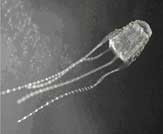The Dangers of a Jellyfish
Sting & What
You Need to Know
 |
| Carukia
barnesi, a tiny jellyfish measuring
the size of a thumbnail, is the only jellyfish proven to cause irukandji syndrome. |
Jellyfish
are not pretty. Not only are they some of the world's strangest looking creatures,
certain varieties can be downright deadly.
An
American tourist, Robert King, died after being stung by a jellyfish while snorkeling
off Australia's northeast coast on the Great Barrier Reef. King is believed to
have developed irukandji syndrome from the sting, causing a rapid rise in blood
pressure and a cerebral hemorrhage.
Just
three months earlier, British
tourist Richard Jordan became the first person on record in Australia to die
from irukandji syndrome after he was stung.
The
Jellyfish and Irukandji Sydrome
Carukia
barnesi, a tiny jellyfish measuring the size of a thumbnail, is the only jellyfish
proven to cause irukandji syndrome. However, it is now believed that a sting from
at least six different species of jellyfish can produce the same symptoms which
include lower back pain, muscle cramps, vomiting, restlessness and anxiety. In
rare cases, the victim can suffer pulmonary oedema (fluid on the lungs) or cardiac
problems that could be fatal if not treated.
The
larger box jellyfish Chironex fleckeri are found in tropical waters from
Exmouth in Western Australia to Agnes Water (near Gladstone) in Queensland. Carukia
barnesi has only been collected close to Cairns in north Queensland, but some
of the species that cause irukandji syndrome are found regularly as far south
as Great Keppel Island, or less frequently as far south as Bundaberg.
Each
year, varying numbers of people are stung - from only a few to more than 200 people.
In the summer of 2001-2002, approximately 160 people were stung by mid February.
Most at risk are snorkelers and divers.
The
initial sting of the jellyfish is usually not very painful. But about 5-45 (usually
30) minutes after being stung, the person starts to have a severe backache or
headache and shooting pains in their muscles, chest and abdomen. They may also
feel nauseous, anxious, restless and vomit. In rare cases, the victim suffers
pulmonary oedema (fluid on the lungs) which could be fatal if not treated.
Treatment
The
sting should be flushed with vinegar and the patient taken to hospital as soon
as possible if they develop irukandji syndrome to be treated for the pain.
Prevention
The
mesh used in stinger-resistant nets in north Queensland is broad enough to kept
out the box jellyfish Chironex fleckeri but allows the small thumnail-sized
C. barnesi to pass through.
A
lycra body suit can help protect against stings although people can be stung where
the suit does not cover the skin - around the feet, neck and head.
(Sources:
CRC
Reef Research Centre, Associated
Press, Dept.
of Pharmacology Research at University of Melbourne)